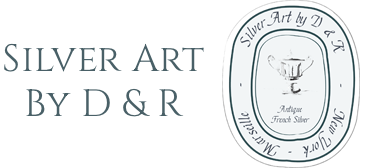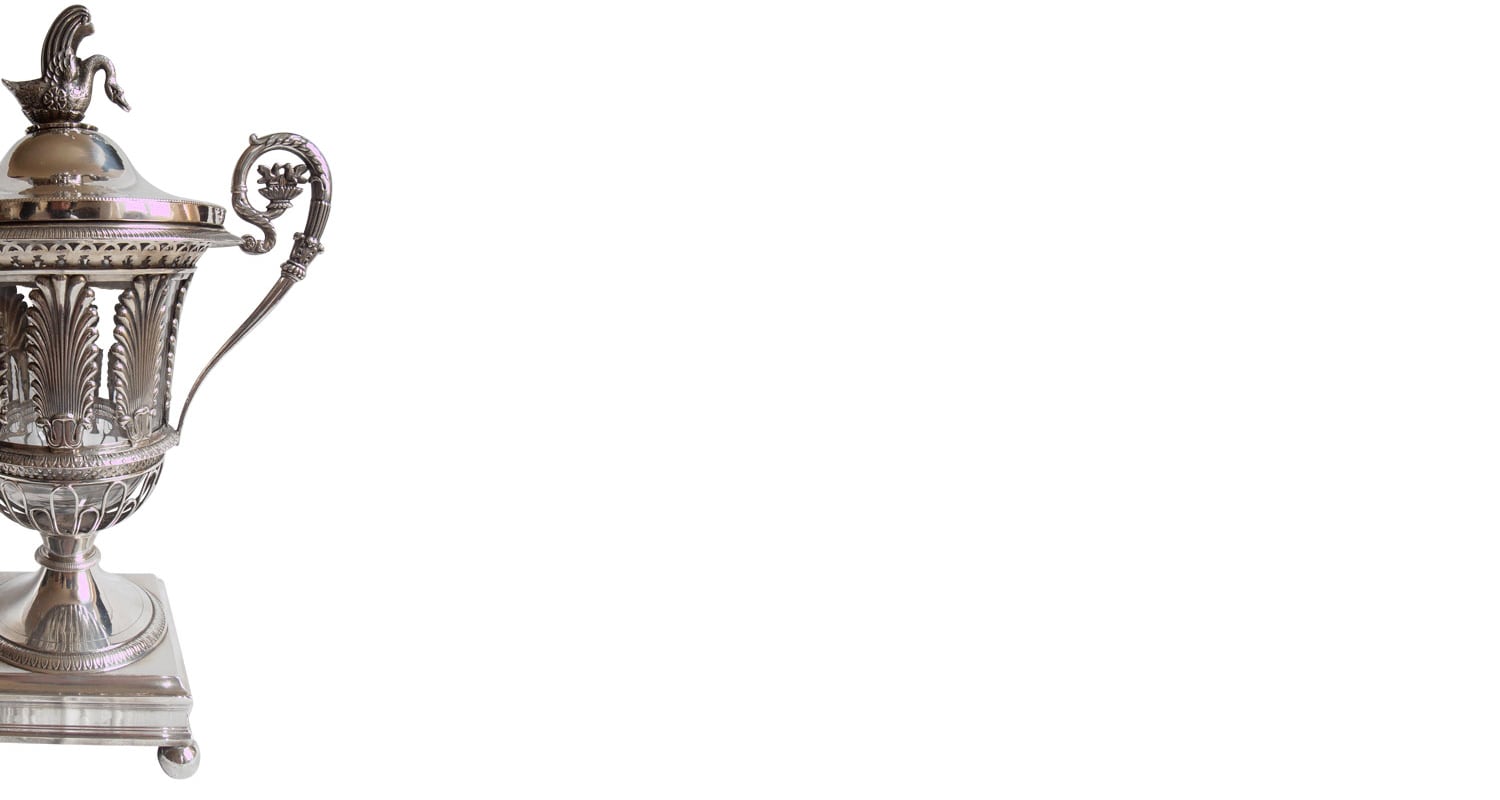We will outline below the main French Silver Hallmarks that will allow you to situate and identify the time frame in which the items were conceived starting from the XIII century.
Trust the French to adopt one of the most complex Hallmark systems to identify their work! Instead of using numbers as in other countries they favoured Symbols… Hence when looking for the Mark you find yourself deciphering heads or shapes of all kind of animals as well as human & super human representation and even insects…
Over the centuries the marks changed, so we can know precisely when the pieces were minted.
But let’s try and keep it as simple as possible, we will only talk of the 950 ‘millièmes’ silver which is the highest denomination for French Silver, since this is what you will find on our website, unless noted differently on the object description. We will not show you pictures in this segment, but we remain at your disposal for more details and will list a bibliography at the end of the paragraph. You will however see pictures of the Hallmarks and Makers Marks for each piece we will present in our ‘Collection’.
-Starting the 13th Century: You can find 2 main marks:
-The ‘Maison Commune Poinçon’ (which translates into Common House Mark) identifying the silver amount as well as the Province it had been minted in.
-The ‘Poinçon d’Orfèvre’ (Makers Mark) showing his initials as well as a mark outlining the fact taxes had been paid.
-From 1698 to 1789:
You can find more then 4 marks: The Silver Guarantee, the Title Hallmark, the Makers Mark but additionally, marks identifying silver content, community/city of origin, tax status and inventory order. The tax status consisted of a charge mark (placed during production after the maker’s and community marks) as well as a discharge mark (placed after taxes’ payment.) These marks were regulated by the local assay office and so serve to identify origin as well.
Pre 1789 marks vary by silver content, assay office, date and whether item was large or small. This means that their number runs into thousands. The French identify the time & marks pre dating 1789 as ‘Fermiers Généraux’ (General Farmers). We are able to specify the year of the minting thanks to a correlation between that Hallmark and the Markers Mark.
-From 1789 to 1798:
A dark period for Arts in general in France, as, while the Revolution cuts a raw path, artisans and artists are left to fend for themselves! On August 4th 1789 all ‘Privileges’ and ‘Corporations’ are abolished and with them disappear: The control of precious metals – The corresponding Hallmarks- All taxes levied.
Silver production will thus become erratic. The Silversmiths decide to re create a semblance of order and produce 4 Hallmarks that are considered the main ‘Revolutionary Hallmarks’’ hence restoring a semblance of order: The Boars’ Head (Tête De Sanglier) – Head of Greek Women (Tête de Femme Grecque -2 were produced) – The Horse’s Head (Tête de Cheval).They are also called ‘Poincons D’Essai’.
-Starting 1798 and until 1809:
You can find 3 marks: the Silver Guarantee (Poinçon de Garantie), the Title hallmark and the Makers Mark (the later was in-sculpted for 1 single Master Silversmith only and usually placed in a lozenge form, several precise records of those marks has been kept).
- The Title Hallmark noted as a Standing Rooster facing to the right but its head looking back with a small ‘1’ in front of it, indicates minting in Paris
- The Title Hallmark noted as a Standing Rooster facing to the right but its head looking back with a small ‘1’ behind it, indicates minting in the Provinces (Countryside)
-Starting 1809 and until 1819:
You can still find 3 marks: the Silver Guarantee (Poinçon de Garantie), the Title hallmark and the Makers Mark.
- The Title Hallmark noted as a Fighting Rooster facing to the right with a small ‘1’ in front of it indicates Paris minting
- The Title Hallmark noted as a Standing Rooster facing to the right with the 1 on top of its head, indicates minting in the Provinces (Countryside)
-Starting 1819 and until 1838:
You can still find 3 marks: the Silver Guarantee, The Title Hallmark and the Makers Mark.
- The Title Hallmark showing the head of Michael Angelo (Michel Ange) also known as Poinçon Au Vieillard (The Oldmans’s Mark) with the head facing right and a small ‘1’ in front of it, indicates minting in Paris
- The Title Hallmark showing as an Old Women’s Head (Tête de Vieille Femme) facing right with a small ‘1’ in the back of it, indicates minting in the Provinces (countryside)
-Starting 1838 and until 1919:
You usually only find 2 marks: the Title Hallmark and the Maker’s Mark. They had finally realized that the Hallmark could also double up as the Silver Guarantee! Knowing that the Markers Mark was unique and only in-sculpted for 1 person we can still know the time frame in which the piece was produced.
- The Title Hallmark for pieces minted in Paris show the Head of the Minerva facing right with a small ‘1’ in front of its forehead.
- The Title Hallmark for the provinces will be identical except for a very small mark (an X) underneath the figure’s chin.
-After 1919 and until today:
The Minerva Mark remained unchanged until 1973. This made the identification of the time frame in which the pieces were created, much harder to verify. It relied mainly on a cross check between the Makers Mark and the Minerva Hallmark. In 1973 the system was updated and it was decided that each 10 year period would be identified by a letter, starting with and A for 1973. This system is still in use today.
For more references on these marks or to go deeper in details, please read or browse
Tardy’s ‘International Hallmarks on Silver’
Yves Markezana’s ‘Les Poinçons Français de 1275 à nos jours’
Beuque & Frapsauce’s ‘Dictionnaire des Poinçons des Maitres Orfèvres Français du XIV Siècle à 1838’
Cahiers Du Patrimoine ‘Dictionnaire des Poinçons des Fabricants d’ouvrages d’Or et d’Argent, Paris et la Seine’
OF TIME AND VALUE
Of course as pieces age, they gain value, and today the pieces dating to the mid 1700 or earlier, are more sought after then the ones produced in the later 1800.
Contributing to this phenomenon is the fact that Antique Silver pieces were very often passed down through the ages by wealthy families. As the fashion changed the heirs wanted to see their objects ‘revamped’ to suit the latest tastes in decoration and tableware. Hence very often the objects were brought back to the Master Silversmith to melt and transform into a more fashionable form.
Another common reason was that the silver value constituted a security deposit for a family and very much worked as our banking system works today. If you needed ready cash, your silver pieces were there to provide it. Families in reversal of fortune could always sell their silver for its face value, after melting it.
Finally after the French revolution a lot of the pieces owned by the wealthy families were looted or stolen and either lost or melted for face value, this unfortunately also holds true for the royal collections which for a large part disappeared. Due to all this a piece minted in the 1700s will have much more value then the later item even though some pieces are more or less refined.
In French the Makers Mark is called the ‘Poinçon d’Orfevre’: ‘orfèvre’ comes from Latin and means ‘the one who works gold’ designating the person who works with precious metals. Today in French ‘Orfèvre’ has come to represent the Master Silversmith who creates objects of virtue or objects related to the ‘Art de la Table’.
VALUED MAKERS MARKS
When referring to the Makers Mark being registered we use the term In-sculpted (Insculpté)- Among the ‘Maîtres Orfèvres’ who have left a valued imprint we can find pre dating 1809:
Jean ETIENNE – His mark was in-sculpted in 1736
Jean Louis MAUZIE – His mark was in-sculpted in 1756
Daniel Toussaint DESMARES – His mark was in-sculpted in 1765
Noel NEUSECOURT – His mark was in-sculpted in 1783
Jean Pierre BIBRON – His mark was in-sculpted in 1798
Louis Joseph THOMAS – His mark was in-sculpted in 1798
Ambroise MIGNEROT – His mark was in-sculpted in 1800
Jean Baptiste Claude ODIOT – His mark was in-sculpted in 1785


